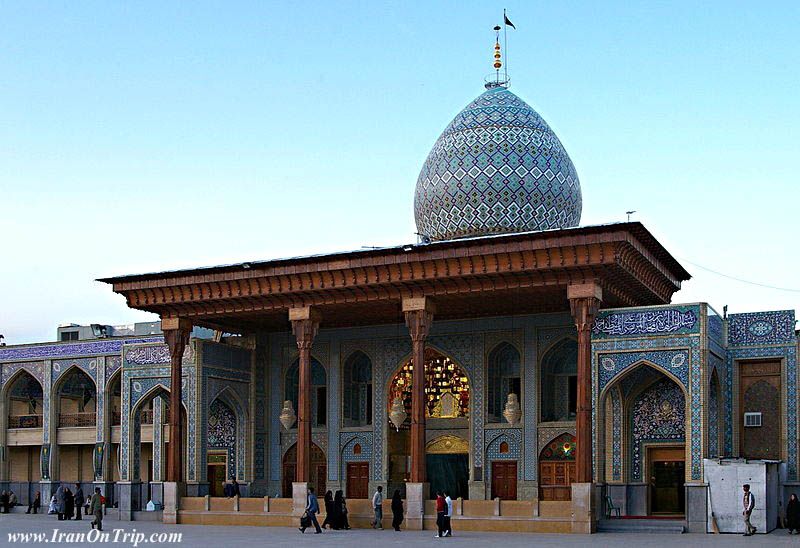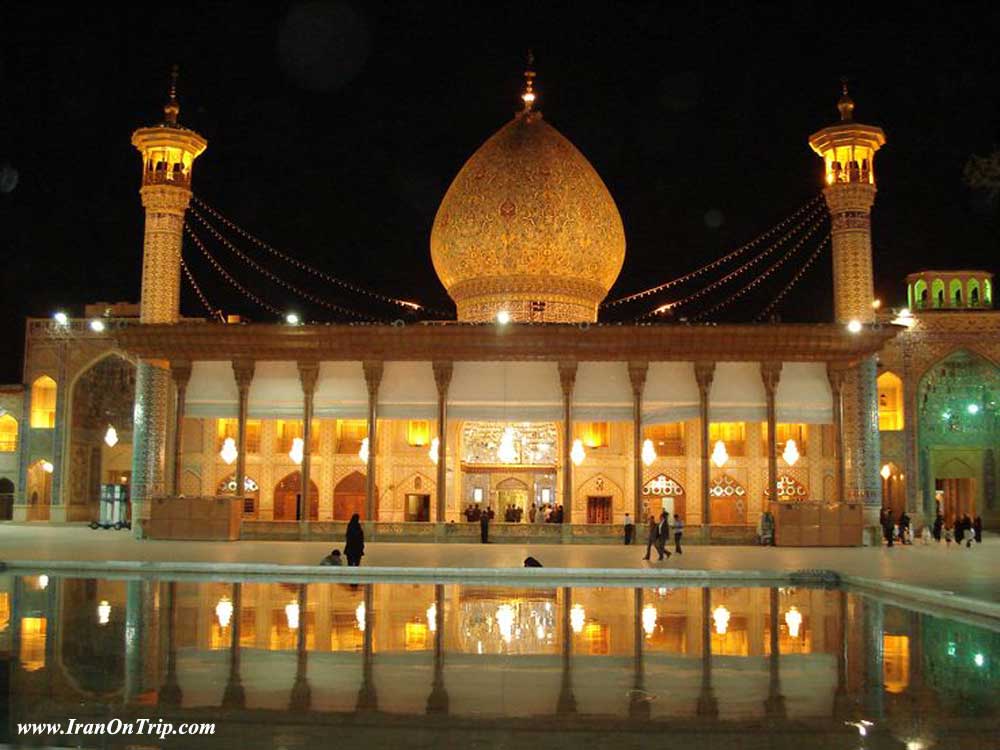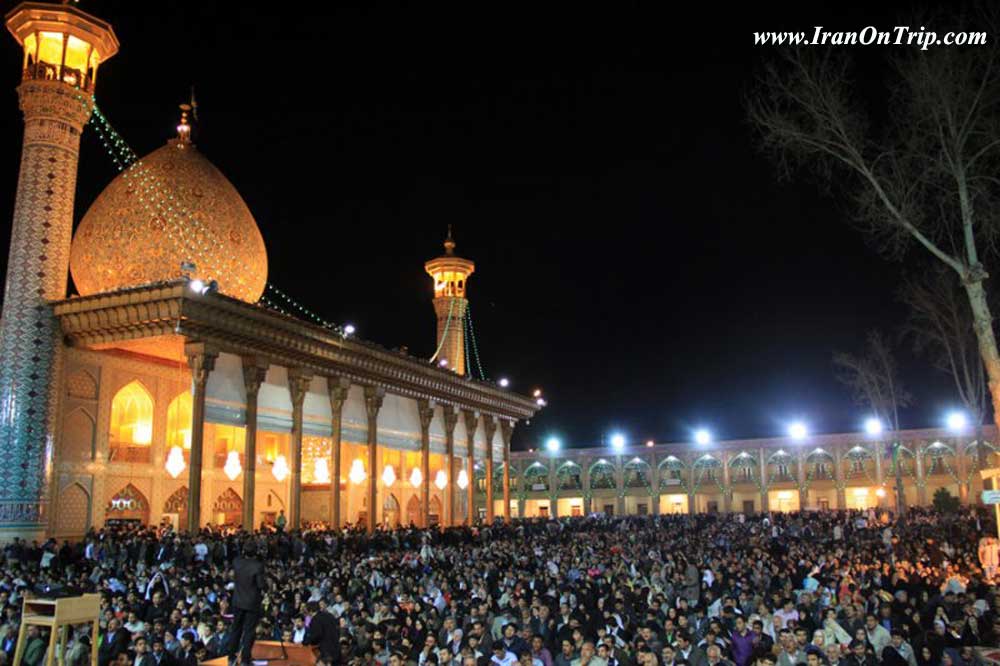Shiraz Shah-e-Cheragh Mausoleum

After the shrines of Imam Reza in Mashhad and Fatima in Qum, the third most venerated pilgrimage destination in Iran is the shrine of Shah Chirag in the city of Shiraz. Archaeological excavation indicates a settlement on the site of Shiraz in the prehistoric period and cuneiform records from the great ceremonial capital of Persepolis, 57 kilometers to the north, show that it was a significant town in Achaemenian times. As a city however, it was founded in 684 AD, after the Arab armies conquered the Sassanians. The Buyids (945-1055 AD) made Shiraz their capital, building mosques, palaces and a great city wall. The 13th and 14th centuries saw Shiraz as a literary center especially famous for its poets Sa'adi and Hafez, both of whom are buried in the city. There are many splendid Islamic monuments in Shiraz, especially its enormous Safavid mosque, but the most notable religious site is the shrine of Syed Amir Ahmad (also called Ahmad ibn Musa).
Amir Ahmad and his brother Mir Muhammad, both of whom were brothers of Imam Reza, took refuge in Shiraz following Abbasid persecution of the Shi'ite sect (Amir Ahmad died or was murdered in 835). The brothers' tombs, originally only simple mausoleums, became celebrated pilgrimage destinations in the 14th century when the pious and art-loving Queen Tashi Khatun erected a mosque and theological school by the tombs. Known locally as Shah Chirag or the 'King of Light', the exquisite tomb of Amir Ahmad is a place of truly stunning beauty. The enormous dome above the shrine is inlaid with hundreds of thousands of pieces of finely crafted tile and the interior walls are likewise covered with myriad pieces of dazzling cut glass intermixed with multi-colored tiles. In the same complex is the mausoleum of Mir Muhammad.
Besides the great pilgrimage shrine of Shah Chirag, Shiraz is also famous for its many Imamzadihs, these being shrines of descendants or relatives of the twelve Shi'ite Imams. The term imamzadih refers to both the shrine structure and the saint associated with the shrine. Different shrines, or rather the imamzadihs watching over them, are believed to possess different miraculous powers and thus pilgrims in Shiraz may seek assistance with such matters as finding a mate, ease in childbirth and treatment of a variety of physical and psychological ailments.
Shah-e-Cheragh Mausoleum

The most important pilgrimage centre of the city of Shiraz is the Mausoleum of Mir Sayyed Ahmad, the son of the seventh Emam known as Shah-e-Cheragh (the Shrine of the lord of the light), which is situated near the Masjed-e-No. Mir Sayyed Ahmad came to Ahiraz at the beginning of the third Islamic century, and died there. After the shrines of Imam Reza in Mashhad and Fatima in Qum, the third most venerated pilgrimage destination in Iran is the shrine of Shah Cherag in the city of Shiraz.
Archaeological excavation indicates a settlement on the site of Shiraz in the prehistoric period and cuneiform records from the great ceremonial capital of Persepolis, 57 kilometers to the north, show that it was a significant town in Achaemenian times. As a city however, it was founded in 684 AD, after the Arab armies conquered the Sassanians.
The Buyids (945-1055 AD) made Shiraz their capital, building mosques, palaces and a great city wall. The 13th and 14th centuries saw Shiraz as a literary center especially famous for its poets Sa'adi and Hafez, both of whom are buried in the city. There are many splendid Islamic monuments in Shiraz, especially its enormous Safavid mosque, but the most notable religious site is the shrine of Syed Amir Ahmad (also called Ahmad ibn Musa).
Amir Ahmad and his brother Mir Muhammad, both of whom were brothers of Imam Reza, took refuge in Shiraz following Abbasid persecution of the Shi'ite sect (Amir Ahmad died or was murdered in 835). The brothers' tombs, originally only simple mausoleums, became celebrated pilgrimage destinations in the 14th century when the pious and art-loving Queen Tashi Khatun erected a mosque and theological school by the tombs. Known locally as Shah Cherag or the 'King of Light', the exquisite tomb of Amir Ahmad is a place of truly stunning beauty. The enormous dome above the shrine is inlaid with hundreds of thousands of pieces of finely crafted tile and the interior walls are likewise covered with myriad pieces of dazzling cut glass intermixed with multi-colored tiles. In the same complex is the mausoleum of Mir Muhammad.

Besides the great pilgrimage shrine of Shah Chirag, Shiraz is also famous for its many imamzadihs, these being shrines of descendants or relatives of the twelve Shi'ite Imams. The term imamzadih refers to both the shrine structure and the saint associated with the shrine. Different shrines, or rather the imamzadihs watching over them, are believed to possess different miraculous powers and thus pilgrims in Shiraz may seek assistance with such matters as finding a mate, ease in childbirth and treatment of a variety of physical and psychological ailments.
The site was given this name due to the nature of the discovery of the site by Ayatullah Dastghā'ib (the great grandfather of the contemporary Ayatullah Dastghā'ib). He used to see light from a distance and decided to investigate the source. He found that the light was being emitted by a grave within a graveyard. The grave that emitted the light was excavated, and a body wearing an armor was discovered. The body was wearing a ring saying "al-‘Izzatu Lillāh, Ahmad bin Mūsā" meaning "The Pride belongs to God, Ahmad son of Musa". Thus it became known that this was the burial site of the sons of Mūsā al-Kadhim.
The site is the most important place of pilgrimage within the city of Shiraz. Ahmad came to Shiraz at the beginning of the third Islamic century (approximately 900 CE), and died there. During the rule of Atabeg Abū Sa'id Zangi (~1130's CE) of the Zengid dynasty, the chief minister to the monarch by the name of Amir Muqarrab al-din Badr al-din built the tomb chamber, the dome, as well as a colonnaded porch. The mosque remained this way for roughly 200 years before further work was initiated by Queen Tash Khātūn (the mother of Shah Abu Ishaq Injū) during the years 1344-1349 (745-750 AH). She carried out essential repairs, constructed an edifice, a hall of audience, a fine college, and a tomb for herself on the south side. She also presented a unique Qur'an of thirty volumes, written in golden Sols characters with gold decoration, in the style of the calligraphist of that period, Yahya Jamali. The date written on the Qur'an indicates that they were written from 1344-1345 (754-746 AH). Nothing now remains of the buildings set up by Queen Tash Khatun, but the Qur'ans have remained and are preserved in the Pars Museum.
The mosque again underwent necessary repairs in 1506 (912 AH - under the reign of Shāh Ismā‘īl I), which were initiated by the guardian of the mosque at the time, Mirza Habibullah Sharifi. The mosque was again repaired in 1588 (997 AH) when half of the structure collapsed as a result of an earthquake. During the nineteenth century, the mosque was damaged several times and was subsequently repaired. In 1827 (1243 AH), Fat'h ‘Alī Shāh Qājār presented an ornamental railing for the tomb. Another earthquake shook the mosque in 1852 (1269 AH), and repairs were carried out by Muhammad Nasir Zahir ad-Dawla.
Finally, the late Nasirol'molk repaired the dome, but on account of the numerous cracks, in 1958 the whole dome was removed, and in its place an iron structure, which was lighter, and likely to last longer, in the shape of the original dome, was made at the cost of the people of Shiraz. The present building consists of the original portico, with its ten columns, on the eastern side, a spacious sanctuary with lofty alcoves on four sides, a mosque on the western side of the sanctuary, and various rooms. There are also numerous tombs contiguous to the Mausoleum.
The decorative work in a mosaic of mirror glass, the inscriptions in stucco, the ornamentation, the doors covered with panels of silver, the portico, and the wide courtyard are most attractive. The tomb, with its latticed railing, is in an alcove between the space beneath the dome and the mosque. And this custom of placing the tomb in this position, so that it is not directly under the dome, is to be seen in other famous places of pilgrimage in the city of Shiraz, and may be considered a special feature of Shiraz shrines. Two short minarets, situated at each end of the columned portico, add impressiveness to the Mausoleum, and to the spacious courtyard, which surrounds it on three sides. The Shah-e-Cheragh Mausoleum was registered on the 20th of the month, Bahman, 1318, under No. 363 in the list of the national monuments of Iran.
.....
.....
.....

.jpg)



























